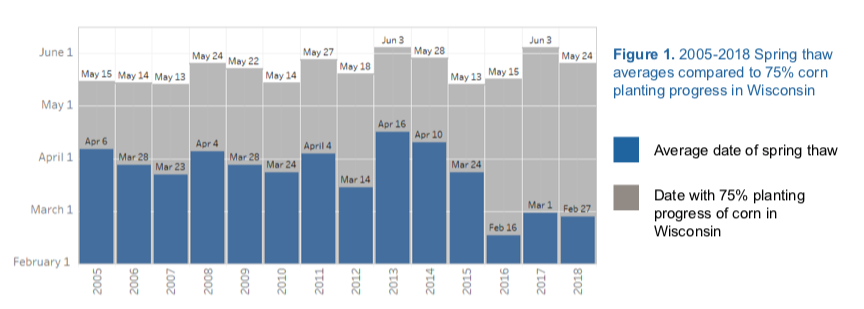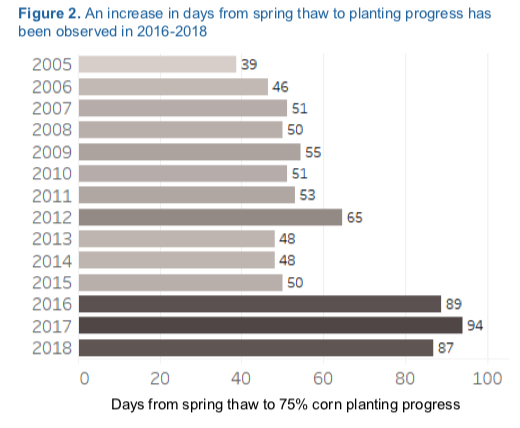Is it just me or are we not allowed to have a spring anymore? This year marks another year of late snowfalls, cold temperatures and delayed planting. In fact, on May 19, only 35% of Wisconsin’s corn crop was planted, compared to the average of 65% corn planting progress for this date, this spring was dreadful and dreary.
Along with all the water quantity and quality data that we collect at Discovery Farms, we also collect weather parameters including soil temperatures. Soil temperature at all our Discovery Farms monitoring sites is collected every 15 minutes at depths of 1, 2, 4, 8, 16 and 32 inches. All of this data is uploaded in real-time to our website (http://www.uwdiscoveryfarms.org/usgs-real-time-data).
We use soil temperature values to define frozen and non-frozen soil periods for our runoff monitoring. Essentially, we use soil temperature to help define when the spring thaw happens and when the switch from snowmelt runoff to rainfall runoff happens. This is extremely important for our runoff research. On average 45% of surface runoff in Wisconsin happens during this frozen soil or snowmelt runoff period. Soil temperature is also very important to planting of spring crops. In general, the faster the soils warm up the faster the planting can progress, although there are many other factors that determine planting progress, including air temperature and precipitation.
Since we have a large amount of soil temperature data going back to 2005, I wanted to explore this data set to see if there has been a trend of later spring thaws recently. Based on my anecdotal thoughts of the past few springs, this must be the case. In figure 1, the blue bars represent the average date of spring thaw observed across our Discovery Farms monitoring sites. As you can see, there isn’t a trend of later spring thaws based on our soil temperature monitoring. In fact, the thaws have happened earlier in 2016, 2017 and 2018. My feelings on the recent lack of spring are not supported by this spring thaw data set.
Figure 1 also depicts the date with 75% corn planting progress in the gray bars. From 2005 through 2015 there was some correlation of spring thaw and 75% corn planting progress. As spring thaw dates got later, so did the date of 75% corn planting progress. As they got earlier so did planting progress. This observation did not hold for 2016, 2017 and 2018. These three years had some of the earliest thaw dates, but the 75% corn planting progress did not happen any earlier.
What did increase in those last three years was the number of days it took to get from spring thaw to 75% corn planting progress across the state. From 2005 to 2015, the number of days from spring thaw to 75% corn planting progress was relatively consistent (about 40-50 days). However, in 2016-2018, this number nearly doubled to around 90 days, indicating that the number of days suitable of spring fieldwork decreased significantly. Those other factors including cold temperatures and excessive precipitation played a big role in this.
2019 seems to be following the recent trend of more days between spring thaw and significant spring planting progress. The number of suitable days for spring fieldwork is low again. Throw in the late spring thaw of 2019 and this helps me understand why it seems like we haven’t had a proper spring lately. UW-Madison Division of Extension Experts have put together a resource page for dealing with extreme weather. Visit: fyi.extension.wisc.edu/grain/extreme-weather. §
- Lessons Learned from Schafer Farms – Implementing Conservation in a Rolling Landscape - April 8, 2020
- What happened to spring? - July 15, 2019
- Tile flow and nutrient movement in Northwest Minnesota - September 13, 2018
